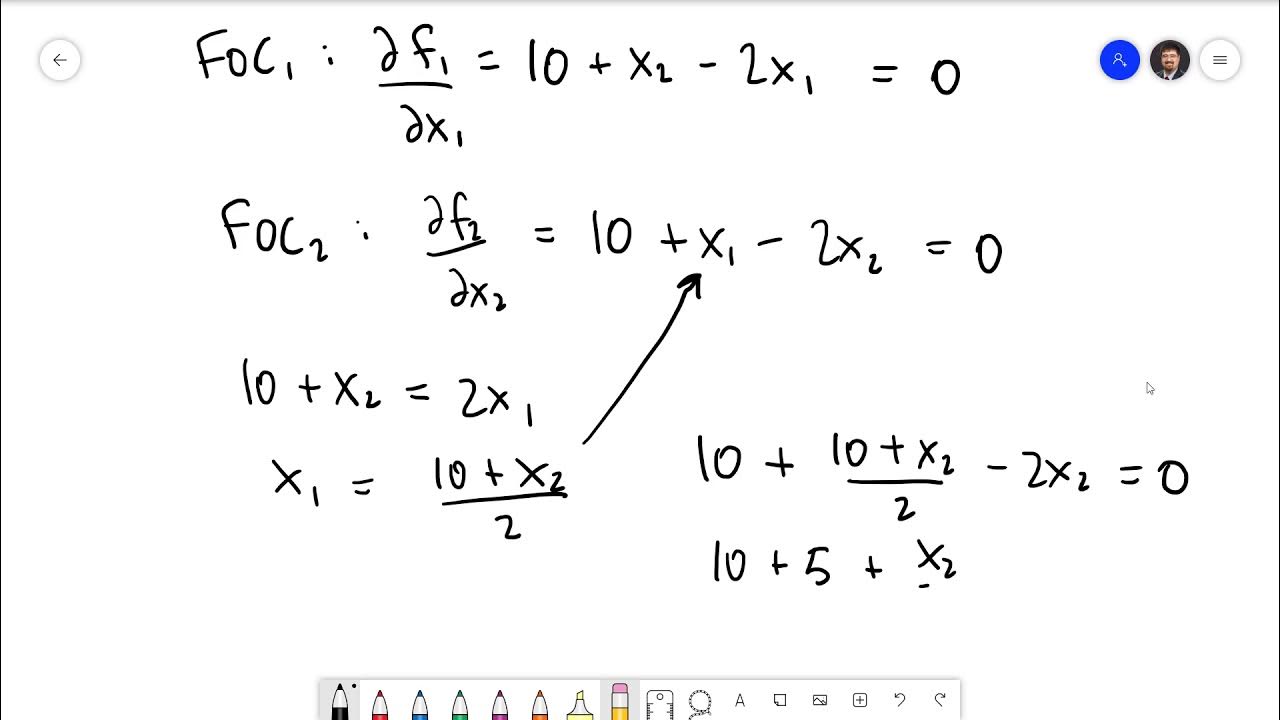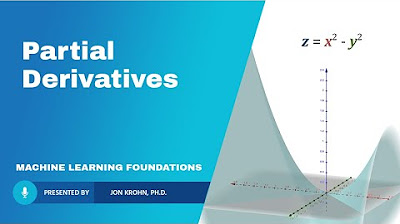Partial Derivatives
TLDRIn this engaging video, Professor Monte dives into the concept of partial derivatives, which are essential when dealing with functions that have more than one independent variable. He begins by introducing Newton's notation and Leibnitz notation for representing functions and then demonstrates how to calculate partial derivatives with respect to each variable while treating the other variables as constants. The video covers straightforward examples as well as more complex functions involving multiple variables. Professor Monte emphasizes understanding the process and encourages learners to practice until they can perform the calculations efficiently. He concludes with an invitation for viewers to subscribe and suggest topics for future videos, fostering a community of learners.
Takeaways
- 📚 Partial derivatives are used when dealing with functions that have more than one independent variable.
- 📝 Two common notations for representing partial derivatives are Newton's notation (f_x) and Leibniz's notation (∂z/∂x).
- 🔍 When taking a partial derivative, one variable is treated as changing while the others are considered constant.
- 🧮 The partial derivative of a constant with respect to a variable is zero.
- 🌟 The partial derivative of 3x with respect to x is 3, as the constant multiple remains when differentiating.
- 🔑 For more complex functions, identify constant multiples and differentiate the variable parts separately.
- 🧬 In the function f(x, y) = 2x + y^2 - 3x^3 + y^6, the partial derivative with respect to x is 2y^2 - 12x^2y^6.
- 🧭 Similarly, the partial derivative with respect to y of the same function is 4xy - 24x^3y^5.
- ⚙️ Leibniz's notation allows for a quicker process by multiplying coefficients and exponents directly during differentiation.
- 🚀 Proficiency in partial derivatives enables one to perform calculations mentally or with less writing, which can be efficient for complex problems.
- 📈 Practice is key to mastering the process of taking partial derivatives, and starting slow can help solidify understanding before moving to quicker methods.
Q & A
What is the main topic of the video?
-The main topic of the video is partial derivatives, specifically how to calculate them when dealing with functions that have more than one independent variable.
What are the two notations used to represent the function in the video?
-The two notations used to represent the function are Newton's notation and Leibnitz notation.
How is the partial derivative with respect to X of the function f(x, y) = 3x + y^5 calculated in Newton's notation?
-In Newton's notation, the partial derivative of F with respect to X is written as F_sub_X. Since there is no X in y^5, it is treated as a constant, and its derivative is zero. Therefore, the partial derivative with respect to X is just 3.
What is the difference between Leibnitz notation and Newton's notation when calculating partial derivatives?
-Leibnitz notation uses a subscript to denote the variable with respect to which the derivative is taken, while Newton's notation uses a subscript with a partial derivative symbol. Both notations yield the same result but have different presentation styles.
How does treating a term without the variable of differentiation as a constant affect the partial derivative calculation?
-When calculating a partial derivative, terms without the variable being differentiated are treated as constants. This means their derivatives are zero, simplifying the calculation.
What is the partial derivative of the function f(x, y) = 2x * y^2 - 3x^2 * y^6 with respect to X?
-The partial derivative of the function with respect to X is 2y^2 - 12x^2 * y^6. The 2x and 3x^2 terms are treated as constants when differentiating with respect to X.
What is the partial derivative of the same function f(x, y) = 2x * y^2 - 3x^2 * y^6 with respect to Y?
-The partial derivative of the function with respect to Y is 4x * y - 24x^3 * y^5. The 2x and 3x^2 terms are treated as constants when differentiating with respect to Y.
What is the advantage of multiplying coefficients and exponents simultaneously when calculating partial derivatives?
-Multiplying coefficients and exponents simultaneously can speed up the process of calculating partial derivatives, especially for more complex functions, without losing accuracy.
What does the video suggest for learners who are comfortable with the concept of partial derivatives?
-The video suggests that if learners are comfortable with the concept, they can perform the calculations more quickly in their heads by applying the rules directly.
How does the video encourage viewers to engage with the content?
-The video encourages viewers to engage by inviting them to subscribe to the channel and to leave suggestions for other videos they would like to see in the chat.
What is the final message conveyed by the Professor in the video?
-The final message is one of encouragement and support, wishing the viewers the best of luck in their understanding and application of partial derivatives.
Outlines
📚 Introduction to Partial Derivatives
This paragraph introduces the concept of partial derivatives, which are used when taking a derivative of a function with more than one independent variable. The video demonstrates two notations for representing partial derivatives: Newton's notation and Leibnitz notation. The example function f(x, y) = 3x + y^5 is used to illustrate how to take the partial derivative with respect to x, treating y as a constant. The process is shown in both notations, emphasizing that the result is the same despite the different presentation.
🔍 Calculating Partial Derivatives in Detail
The second paragraph delves into a more complex function involving both x and y variables within the same term. The process of taking partial derivatives with respect to x is explained, emphasizing the constant multiples and how they behave during differentiation. The function 2x + y^2 - 3x^3 + y^6 is used to illustrate this, and the partial derivative with respect to x is derived as 2y^2 - 12x^2y^6. Similarly, the partial derivative with respect to y is calculated, resulting in 4xy - 24x^3y^5. The paragraph concludes with a faster method for calculating partial derivatives using Leibnitz notation, which involves multiplying coefficients and exponents simultaneously.
Mindmap
Keywords
💡Partial Derivatives
💡Newton's Notation
💡Leibnitz Notation
💡Independent Variables
💡Derivative
💡Constant Multiple Rule
💡Function of Multiple Variables
💡Exponents
💡Coefficients
💡Product Rule
💡Chain Rule
Highlights
Introduction to partial derivatives when dealing with functions of multiple independent variables
Differentiation between Newton's notation (f(x, y) = 3x + y^5) and Leibnitz notation (∂Z/∂X) for representing partial derivatives
Process of taking a partial derivative by holding all other variables constant while varying one
Example calculation of ∂f/∂X for f(x, y) = 3x + y^5, resulting in 3
Explanation of treating variables without the derivative being taken as constants, leading to a zero contribution
Demonstration of partial derivatives in more complex functions involving products of variables
Technique of factoring out constants and coefficients when calculating partial derivatives for efficiency
Example calculation showing ∂f/∂X of a function resulting in 2y^2 - 12x^2y^6
Methodology for calculating ∂f/∂Y, emphasizing the constant multiple rule and its application
Result of ∂f/∂Y calculation is 4xy - 24x^3y^5, showcasing the process step by step
Use of Leibnitz notation to streamline the process of calculating partial derivatives
Emphasizing the importance of understanding the conceptual approach before applying shortcuts
Encouragement to practice both slow and fast methods of calculation based on individual learning pace
Illustration of the partial derivative process using both Newton's and Leibnitz notations for clarity
Mentor's advice on when to use mental calculations for efficiency in experienced learners
Invitation to subscribe for more educational content on calculus
Call for viewer suggestions for future video topics
Closing with well wishes and motivation for learners to master the concept of partial derivatives
Transcripts
Browse More Related Video

Math 11 - Sections 6.1- 6.2

Partial Derivatives - Multivariable Calculus

Managerial Economics 1.3: Partial Derivatives

Partial derivatives 2 | Multivariable Calculus | Khan Academy

MultiVariable Calculus - Implicit Differentiation

What Partial Derivatives Are (Hands-on Introduction) — Topic 67 of Machine Learning Foundations
5.0 / 5 (0 votes)
Thanks for rating: